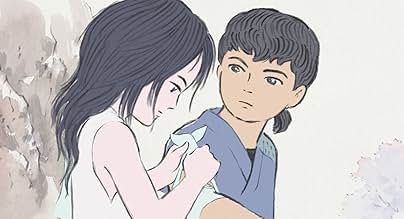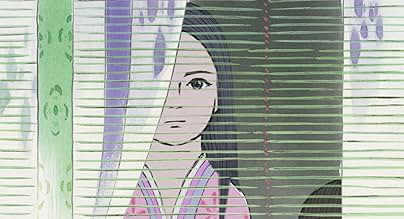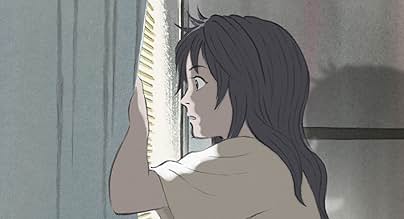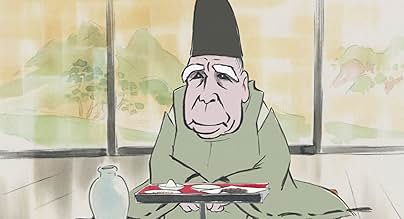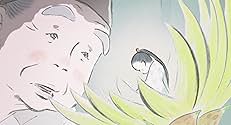Après avoir été trouvée à l'intérieur d'une tige brillante de bambou par un vieux coupeur de bambou et sa femme, une fille minuscule grandit rapidement pour devenir une jeune femme exquise. ... Tout lireAprès avoir été trouvée à l'intérieur d'une tige brillante de bambou par un vieux coupeur de bambou et sa femme, une fille minuscule grandit rapidement pour devenir une jeune femme exquise. La mystérieuse jeune princesse fascine tous ceux qui la croisent, mais elle doit finalemen... Tout lireAprès avoir été trouvée à l'intérieur d'une tige brillante de bambou par un vieux coupeur de bambou et sa femme, une fille minuscule grandit rapidement pour devenir une jeune femme exquise. La mystérieuse jeune princesse fascine tous ceux qui la croisent, mais elle doit finalement affronter son destin, la punition pour son crime.
- Réalisation
- Scénario
- Casting principal
- Nommé pour 1 Oscar
- 13 victoires et 38 nominations au total
- The Princess Kaguya
- (English version)
- (voix)
- The Bamboo Cutter
- (English version)
- (voix)
- The Bamboo Cutter's Wife
- (English version)
- (voix)
- …
- Prince Ishitsukuri
- (English version)
- (voix)
- Kaguya hime
- (voix)
- …
- Sutemaru
- (voix)
- Okina
- (voix)
- Ôna
- (voix)
- …
- Sagami
- (voix)
- Menowarawa
- (voix)
Avis à la une
Based on a 10th century Japanese folktale, The Tale of Princess Kaguya is a bittersweet coming of age story. Our protagonist is Kaguya-hime who is discovered as a baby in a bamboo stalk by an old peasant man. He and his childless wife raise her as their own, providing the best they can as she rapidly ages. While her mother is fearful of change and just wants a comfortable life for her adopted daughter, her father envisions great things. He sees Kaguya as part of a divine plan and after fine clothes and gold come shooting out of bamboo stalks he concludes that the heavens want her to become a proper princess. He assumes this is the best way to make his daughter happy instead of asking her what she wants.
A sharply observed feminist critique of traditional Japanese culture as well as a cautionary tale of the burdens we place on our children, The Tale of Princess Kaguya has a wealth of complex themes and archetypes hidden beneath the surface of its fairly straight- forward story. This is one of the rare films that are both easily accessible to a young audience and one that film students can write thesis papers on.
The final word should be reserved for Studio Ghibli's animation. The style used invokes something between impressionist paintings and water-colours while employing a muted palette. Ghibli moves away from traditional anime and the results are breathtaking. The hand drawn frames could each stand alone as a portrait and yet the film feels fluid. At times the animation blurs into expressionism; the brush strokes matching the characters inner- turmoil.
Easily the best animated film of the year, it's a must see for fans of the genre. Luckily North America will get a theatrical release; the English-dubbed version will be out October 17 and will star Chloe Grace Moretz as Kaguya.
I really appreciated how much effort was put into capturing the atmosphere of the original material. I haven't read the original material so I don't know how faithful it is to the original as a story, but I also liked the things I thought the movie said about women, life, and women's place in society.
I felt like the story was dragging its feet in places. I generally expect fable-style stories to be faster so that they can appeal to a wider audience and not cause you to start questioning the surreal world.
I want to repeat it for the last time. If you want to experience a fable, there are few, if any, better options to watch.
The Tale of the Princess Kaguya tells the story of its titular character who was found in a bamboo shoot by a bamboo cutter who, believing her to be a divine presence, brings her home to his wife. Although this mysterious tiny girl grows rapidly into a young lady, dazzling all who encounters her, she eventually is left with no alternative but to confront her own fate.
Co-written & directed by Isao Takahata (best known for Grave of the Fireflies), this tale is crafted with precision care & elegance plus how all of it is animated brings an artistic vibe of its own. The use of colour palette, sketch-like animation & minimalist approach leaves a lasting impression, the voice performances are spot-on while Joe Hisaishi's score nicely compliments the whole narrative.
The Tale of the Princess Kaguya also covers the various restraints women find themselves in every facet of life, no matter what society they happen to be part of, and exposes that without preaching. However, its 137 minutes of runtime feels a tad too long, the final act is stretched, and although its creativity is undeniably impressive, the whole story kind of lacks that immersive element, much like Takahata's earlier works.
On an overall scale, The Tale of the Princess Kaguya brims with some truly astonishing images and is another winning marvel from the acclaimed studio. It's aesthetically pleasing, artistically fulfilling & emotionally gripping and there are going to be many who will have nothing but endless praise for the manner in which this ancient Japanese folklore is illustrated on the film canvas. As for me, I do admire a number of things about Takahata's latest but don't feel any love for it. Still, I've no qualms in recommending it to anyone for it is worthy of a broader audience.
I love the way animation can take such simple things as eating a melon or watching birds fly into a tree so much more exciting. By using traditional animation (although I need notice some computerize layouts),The Japanese have done it again with their personal approach to the detail of animation you can only get from 2D.
Adding to my enjoyment, this English adaption of the film includes the voice talent of Chloë Grace Moretz as the princess, who I've become a fan of.
It was very beautiful artwork moving across the big screen.
Le saviez-vous
- AnecdotesIn several scenes in the movie, Kaguma-Hime, Lady Sagami and Ona can be seen wearing multi-layered kimonos called Junihitoe. Both the number of layers and the coloring of the layers worn would be dictated by the occasion, status, and season the wearer is in.
- GaffesWhile the baby princess crawls to the cutter she tosses a piece of bamboo to the edge of the floor mat. In the reverse shot as she crawls back, it is missing.
- Citations
The Princess Kaguya: [singing] Go round, come round, come round... Come round, oh distant time. Come round, call back my heart. Come round, call back my heart. Birds, bugs, beasts, grass, trees, flowers. Teach me how to feel. If I hear that you pine for me, I will return to you.
- ConnexionsFeatured in Troldspejlet: Épisode #50.12 (2014)
Meilleurs choix
- How long is The Tale of The Princess Kaguya?Alimenté par Alexa
Détails
Box-office
- Budget
- 5 000 000 000 JPY (estimé)
- Montant brut aux États-Unis et au Canada
- 974 913 $US
- Week-end de sortie aux États-Unis et au Canada
- 54 915 $US
- 19 oct. 2014
- Montant brut mondial
- 24 751 400 $US
- Durée2 heures 17 minutes
- Couleur
- Mixage
- Rapport de forme
- 1.85 : 1
Contribuer à cette page








